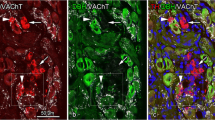Summary
There are species differences with regard to the composition of the ciliary ganglion. For instance, in rabbits and cats it consists solely of oculomotor nerves and has no sympathetic or sensory innervation. The purpose of this study is to clarify the participation of these nerves in the ciliary ganglion of the dog by histochemical methods. Cholinesterase (ChE) activity was studied by Karnovsky's method and catecholamine fluorescence by the glyoxylic acid method. Furthermore, the origins of the respective nerves were investigated by a serial preparation method, involving unilateral cervical sympathectomy and tracer dye injection in the ganglion. The results obtained were: (1) Ciliary ganglion cells showed intense ChE activity. Oculomotor nerve fibers leading to the ganglion showed moderate ChE activity, while the reaction in the short ciliary nerves was strong. (2) Aminergic nerves were present in the intercellular space of the ciliary ganglion, and bilateral or central innervation was suggested by the results of cervical sympathectomy. (3) Connection between the ciliary and trigeminal ganglia was proved by the dye tracer study. The results show that the ciliary ganglion in dogs is composed of oculomotor, trigeminal and sympathetic nerves.
Similar content being viewed by others
References
Akert K, Glicksman MA, Lang W, Grob P, Huber A (1980) The Edinger-Westphal nucleus in the monkey. A retrograde tracer study. Brain Res 184:491–498
Bentivoglio M, Kooy D, Kuypers HGJM (1979) The organization of the efferent projections of the substantia nigra in the rat. A retrograde fluorescent double labeling study. Brain Res 174:1–17
Ehinger B (1966) Ocular and orbital vegetative nerves. Acta Physiol Scand 69 (Suppl) 286:1–83
El-Badawi A, Schenk EA (1967) Histochemical methods for separate, consecutive and simultaneous demonstration of acetylcholinesterase and norepinephrine in cryostat sections. J Histochem Cytochem 15:580–588
Eränkö O (1955) Distribution of fluorescing islets, adrenaline in the adrenal medulla of the hamster. Acta Endocrinol (Kbh) 18:174–179
Eränkö O, Härkönen M (1964) Noradrenaline and acetylcholinesterase in sympathetic ganglion cells of the rat. Acta Physiol Scand 61:299–300
Falck B (1962) Observations on the possibilities of the cellular localization of monoamines by a fluorescence method. Acta Physiol Scand 56 (Suppl) 197:1–25
Grimes P, von Sallmann L (1960) Comparative anatomy of the ciliary nerves. Arch Ophthalmol 64:81–91
Hamberger B, Norberg K, Ungerstedt U (1965) Adrenergic synaptic terminals in autonomic ganglia. Acta Physiol Scand 64:285–286
Huikuri KT (1966) Histochemistry of the ciliary ganglion of the rat and the effect of preand postsynaptic nerve division. Acta Physiol Scand 69 (Suppl) 286:1–83
Jacobowitz D, Koelle GB (1965) Histochemical correrations of acetylcholinesterase and catecholamines in postganglionic autonomic nerves of the cat, rabbit, and guinea pig. J Pharmacol Exp Ther 148:225–237
Karnovsky MJ, Roots L (1964) A “direct-coloring” thiocholine method for cholinesterase. J Histochem Cytochem 12:219–221
Koelle WA, Koelle GB (1959) The localization of external or functional acetylcholinesterase at the synapses of autonomic ganglia. J Pharmacol Exp Ther 126:1–8
Marin J, Salaices M, Rivilla F, Burgos J, Marco EJ (1980) Bilateral innervation of the cerebral arteries by the superior cervical ganglion in cats. J Neurosurg 53:88–91
Sunderland S, Huges ESR (1946) The pupilloconstrictor pathway and the nerves to the ocular muscles in man. Brain 69:301–309
Sawchenko PE, Swanson LW (1981) A method for tracing biochemically defined pathways in the central nervous system using combined fluorescence retrograde transport and immunohistochemical techniques. Brain Res 210:31–51
Tervo T (1977) Consecutive demonstration of nerves containing catecholamine and acetylcholinesterase in the rat cornea. Histochemistry 50:291–299
Walsh FB, Hoyt WF (1969) Clinical neuro-ophthalmology, 3rd edit. Williams & Wilkins, Baltimore, pp 471–472
Waris T, Rechardt L (1977) Histochemically demonstrable cathecholamines and cholinesterases in nerve fibers of rat dorsal skin. Histochemistry 53:203–216
Warwick R (1954) The ocular parasympathetic nerve supply and its mesencephalic sourses. J Anat 88:71–93
Williams PL, Warwick G (1975) Functioning neuroanatomy of man. WB Saunders, Philadelphia, pp 998–1000
Author information
Authors and Affiliations
Rights and permissions
About this article
Cite this article
Hara, H., Kobayashi, S., Sugita, K. et al. Innervation of dog ciliary ganglion. Histochemistry 76, 295–301 (1982). https://doi.org/10.1007/BF00543952
Received:
Accepted:
Issue Date:
DOI: https://doi.org/10.1007/BF00543952




